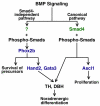BMP signaling regulates sympathetic nervous system development through Smad4-dependent and -independent pathways
- PMID: 19793887
- PMCID: PMC2761108
- DOI: 10.1242/dev.038133
BMP signaling regulates sympathetic nervous system development through Smad4-dependent and -independent pathways
Abstract
Induction of the sympathetic nervous system (SNS) from its neural crest (NC) precursors is dependent on BMP signaling from the dorsal aorta. To determine the roles of BMP signaling and the pathways involved in SNS development, we conditionally knocked out components of the BMP pathways. To determine if BMP signaling is a cell-autonomous requirement of SNS development, the Alk3 (BMP receptor IA) was deleted in the NC lineage. The loss of Alk3 does not prevent NC cell migration, but the cells die immediately after reaching the dorsal aorta. The paired homeodomain factor Phox2b, known to be essential for survival of SNS precursors, is downregulated, suggesting that Phox2b is a target of BMP signaling. To determine if Alk3 signals through the canonical BMP pathway, Smad4 was deleted in the NC lineage. Loss of Smad4 does not affect neurogenesis and ganglia formation; however, proliferation and noradrenergic differentiation are reduced. Analysis of transcription factors regulating SNS development shows that the basic helix-loop-helix factor Ascl1 is downregulated by loss of Smad4 and that Ascl1 regulates SNS proliferation but not noradrenergic differentiation. To determine if the BMP-activated Tak1 (Map3k7) pathway plays a role in SNS development, Tak1 was deleted in the NC lineage. We show that Tak1 is not involved in SNS development. Taken together, our results suggest multiple roles for BMP signaling during SNS development. The Smad4-independent pathway acts through the activation of Phox2b to regulate survival of SNS precursors, whereas the Smad4-dependent pathway controls noradrenergic differentiation and regulates proliferation by maintaining Ascl1 expression.
Figures








Similar articles
-
Essential role of Gata transcription factors in sympathetic neuron development.Development. 2004 Oct;131(19):4775-86. doi: 10.1242/dev.01370. Epub 2004 Aug 25. Development. 2004. PMID: 15329349
-
Altered BMP-Smad4 signaling causes complete cleft palate by disturbing osteogenesis in palatal mesenchyme.J Mol Histol. 2021 Feb;52(1):45-61. doi: 10.1007/s10735-020-09922-4. Epub 2020 Nov 7. J Mol Histol. 2021. PMID: 33159638
-
Smad4 is required predominantly in the developmental processes dependent on the BMP branch of the TGF-β signaling system in the embryonic mouse retina.Invest Ophthalmol Vis Sci. 2011 May 2;52(6):2930-7. doi: 10.1167/iovs.10-5940. Invest Ophthalmol Vis Sci. 2011. PMID: 21273545 Free PMC article.
-
Bone morphogenetic proteins.Growth Factors. 2004 Dec;22(4):233-41. doi: 10.1080/08977190412331279890. Growth Factors. 2004. PMID: 15621726 Review.
-
Perspectives on integration of cell extrinsic and cell intrinsic pathways of signaling required for differentiation of noradrenergic sympathetic ganglion neurons.Auton Neurosci. 2006 Jun 30;126-127:225-31. doi: 10.1016/j.autneu.2006.02.029. Epub 2006 May 2. Auton Neurosci. 2006. PMID: 16647305 Review.
Cited by
-
Taste papilla cell differentiation requires the regulation of secretory protein production by ALK3-BMP signaling in the tongue mesenchyme.Development. 2023 Sep 15;150(18):dev201838. doi: 10.1242/dev.201838. Epub 2023 Sep 25. Development. 2023. PMID: 37680190 Free PMC article.
-
Cardiopulmonary and Neurologic Dysfunctions in Fibrodysplasia Ossificans Progressiva.Biomedicines. 2021 Feb 5;9(2):155. doi: 10.3390/biomedicines9020155. Biomedicines. 2021. PMID: 33562570 Free PMC article. Review.
-
Expansion of a neural crest gene signature following ectopic MYCN expression in sympathoadrenal lineage cells in vivo.PLoS One. 2024 Sep 18;19(9):e0310727. doi: 10.1371/journal.pone.0310727. eCollection 2024. PLoS One. 2024. PMID: 39292691 Free PMC article.
-
Highly distinct genetic programs for peripheral nervous system formation in chordates.BMC Biol. 2022 Jun 27;20(1):152. doi: 10.1186/s12915-022-01355-7. BMC Biol. 2022. PMID: 35761237 Free PMC article.
-
Oncogenic LMO3 collaborates with HEN2 to enhance neuroblastoma cell growth through transactivation of Mash1.PLoS One. 2011 May 5;6(5):e19297. doi: 10.1371/journal.pone.0019297. PLoS One. 2011. PMID: 21573214 Free PMC article.
References
-
- Chalazonitis, A., D'Autreaux, F., Guha, U., Pham, T. D., Faure, C., Chen, J. J., Roman, D., Kan, L., Rothman, T. P., Kessler, J. A. et al. (2004). Bone morphogenetic protein-2 and -4 limit the number of enteric neurons but promote development of a TrkC-expressing neurotrophin-3-dependent subset. J. Neurosci. 24, 4266-4282. - PMC - PubMed
-
- D'Autreaux, F., Morikawa, Y., Cserjesi, P. and Gershon, M. D. (2007). Hand2 is necessary for terminal differentiation of enteric neurons from crest-derived precursors but not for their migration into the gut or for formation of glia. Development 134, 2237-2249. - PubMed
-
- Dai, Y. S., Hao, J., Bonin, C., Morikawa, Y. and Cserjesi, P. (2004). JAB1 enhances HAND2 transcriptional activity by regulating HAND2 DNA binding. J. Neurosci. Res. 76, 613-622. - PubMed
-
- Danielian, P. S., Muccino, D., Rowitch, D. H., Michael, S. K. and McMahon, A. P. (1998). Modification of gene activity in mouse embryos in utero by a tamoxifen-inducible form of Cre recombinase. Curr. Biol. 8, 1323-1326. - PubMed
Publication types
MeSH terms
Substances
Grants and funding
LinkOut - more resources
Full Text Sources
Molecular Biology Databases
Miscellaneous

